The evolution from the Venus Cal. 188 (7730) to the Valjoux Cal. 7750 (ETA 7750)
Since the first automatic chronograph was released in 1969, all wristwatches released since then have basically been quartz or automatic chronographs, with no manual winding.
This is because, to begin with, making an automatic chronograph in modern times would not be profitable and it would be prone to malfunction.
However, we still feel that watches equipped with such time-consuming, labor-intensive hand-wound movements are superior.
So, today I would like to talk about the history of manual-winding and automatic movements and their respective features.
By listening to this story until the end, I think you will change your mind about the idea that hand-wound movements are always better.
The table of contents is as follows.
1. The history of manual-winding chronograph movements
2. History of Venus Company
3. From Valjoux Cal. 7730 to Cal. 7733
4. The Birth of the Chronomatic Cal.11
5. The Birth of the Valjoux Cal. 7750
Finally, here is a summary.
To watch the video, click here↓
The History of Manual Chronograph Movements
There are many movement (embouge) brands in Switzerland, but there are only a limited number of companies that can make movements for chronographs.
This is simply because there are more parts than in a three-hand watch, and the design is proportionately more difficult.
Therefore, not all brands were able to make these movements, and only a limited number of manufacturers produced them, and each brand converted the movements for their own use and installed them in their watches.
The two leading movement manufacturers were Valjoux and Venus.
Valjoux watches were used by many brands and were more well-known, but Venus watches quickly became more well-known after being used in Breitling's Chronomat and Navitimer watches.
First, let me explain the history of Venus.
History of Venus
Venus is a chronograph movement manufacturer founded in 1924.
Venus' first movement was the Cal. 140 in 1935.
This movement is generally installed in many Garrett Multichron watches, and is characterized by having vertical grain, unlike today's movements.
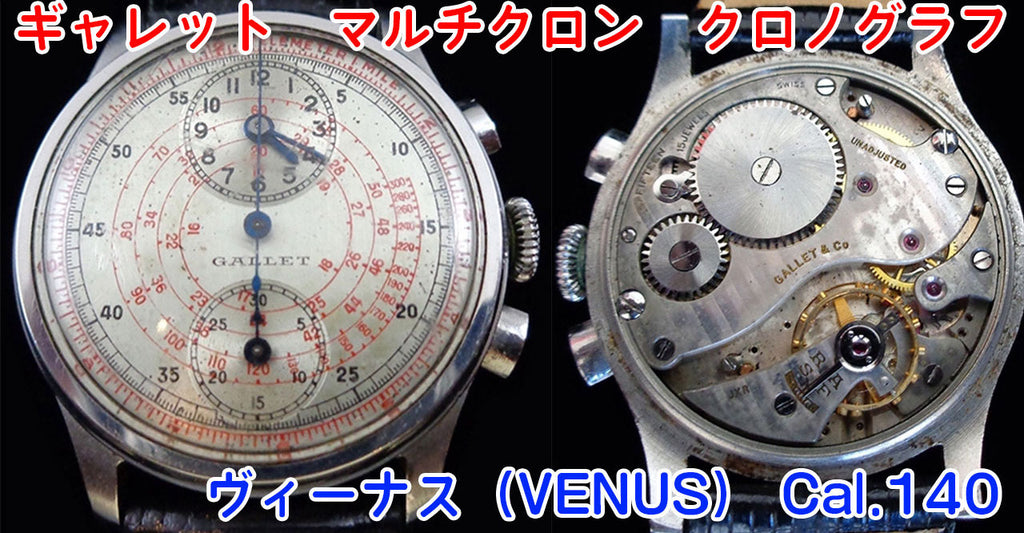
This dial is read as follows:
・Hour and minute counter at 12 o'clock
・30-minute counter at 6 o'clock
-Chronograph hand in the center of the text
It is as follows.
Subsequently, in 1940, the horizontal-grain Cal. 150 and the vertical-grain Cal. 170 were developed.
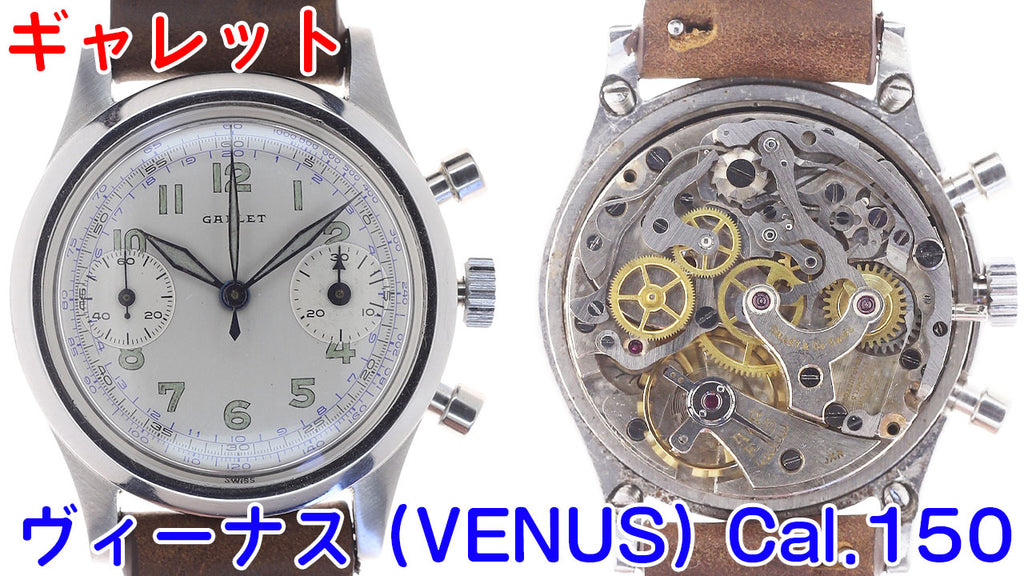
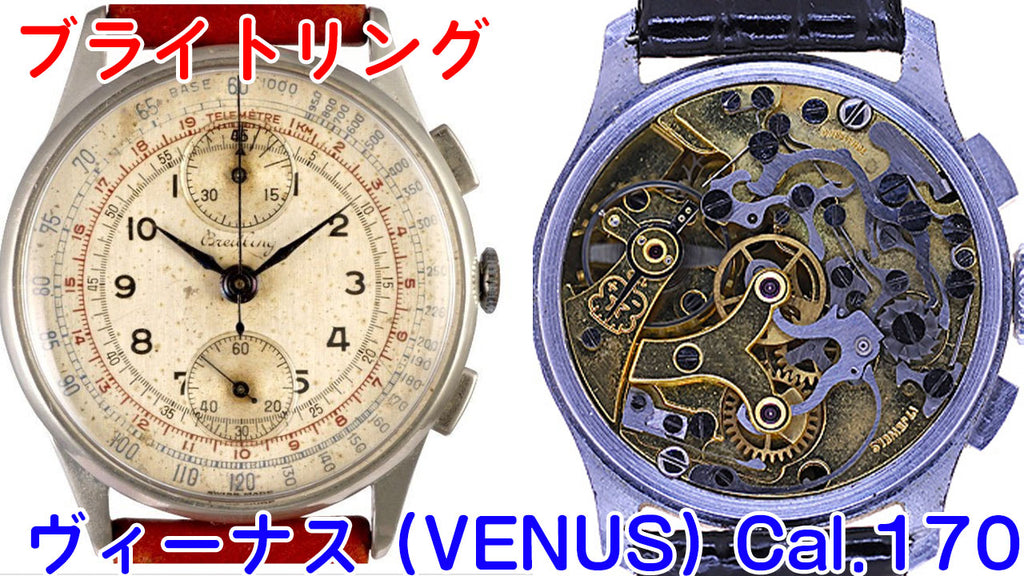
The Cal. 175, which was installed in the first Chronomat released by Breitling in 1942, was an improvement on this horizontal-eye Cal. 150.
 After the birth of the Chronomat, the Cal. 178 was born, which was equipped with a 12-hour counter on the Cal. 175, and this was adopted by Breitling for the Navitimer, which was released in 1952.
After the birth of the Chronomat, the Cal. 178 was born, which was equipped with a 12-hour counter on the Cal. 175, and this was adopted by Breitling for the Navitimer, which was released in 1952.
This cal. 178 is Venus' signature movement, and is probably the one most people are familiar with.
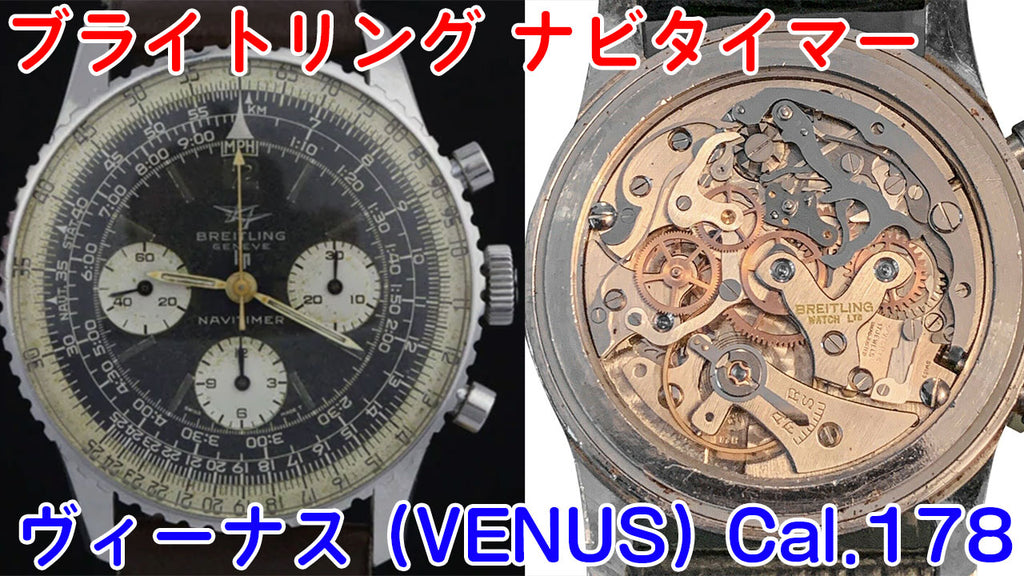
In this way, vertical-grain movements evolved from Cal. 140 to 170, but probably due to visibility issues, horizontal-grain chronographs became the norm, evolving from Cal. 150 to 175 to 178.
Up until this point, most movements used a column wheel mechanism, but beginning in the 1920s, rising labor costs in Europe made it unprofitable to produce complex movements that required human labor.
It was at this time that Cal.188, an evolution of Cal.178, was born.
So please take a look at this image.
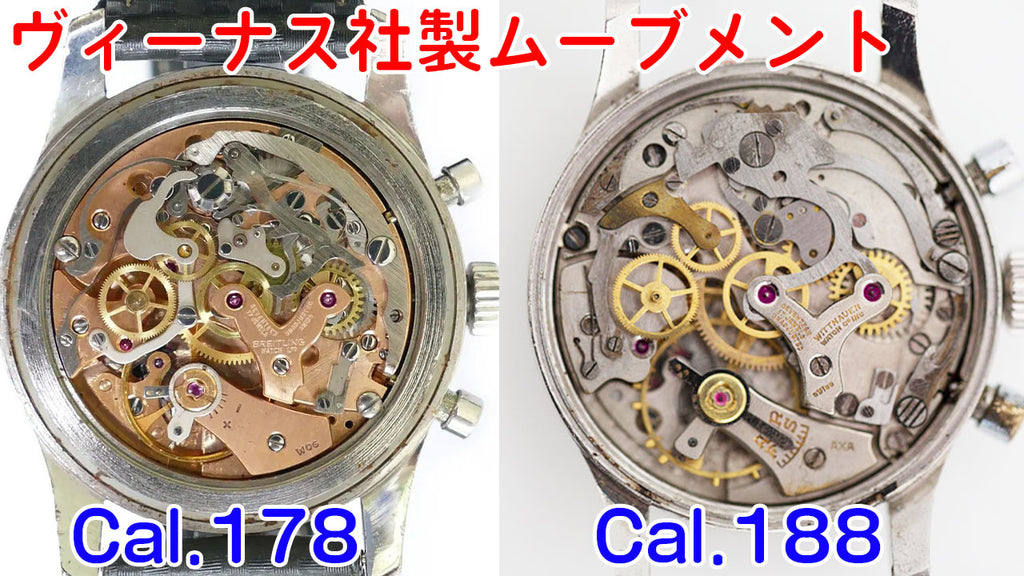
First, the one on the left is ``Cal.178'' and the one on the right is ``Cal.188''.
Although they look almost identical, the base plate and gear train are the same, but the column wheel that was installed in the 178 is gone, and the 188 uses a cam system.
In addition, the brake lever has been eliminated to reduce costs.
Although Venus was able to develop movements that could be produced cheaply in response to rising labor costs, it was unable to go against the trend of the times and went bankrupt in 1966.
And it was the second company, Valjoux, that bought the bankrupt Venus.
Now let's take a look at the subsequent succession of movements between Venus and Valjoux.
From the Valjoux Cal. 7730 to the Cal. 7733
The Cal. 188, created by Venus, was acquired by Valjoux and changed its name to Cal. 7730, although the basic structure is almost the same.
Therefore, it is fine to think of the Venus Cal. 188 and the Valjoux Cal. 7730 as the same movement.
And as explained earlier, these movements do not have brake levers in order to reduce costs.
So, what role does this brake lever play? Simply put, it has the role of preventing malfunction.
Even though they can now be made cheaply, movements that affect accuracy may be used in commercially available products, but they have never been used in situations where truly precise accuracy is required, such as for military use.
As a result, Valjoux made improvements to the problematic Valjoux 7730 (Venus Cal. 188) and released a new model.
This is the Valjoux 7733.
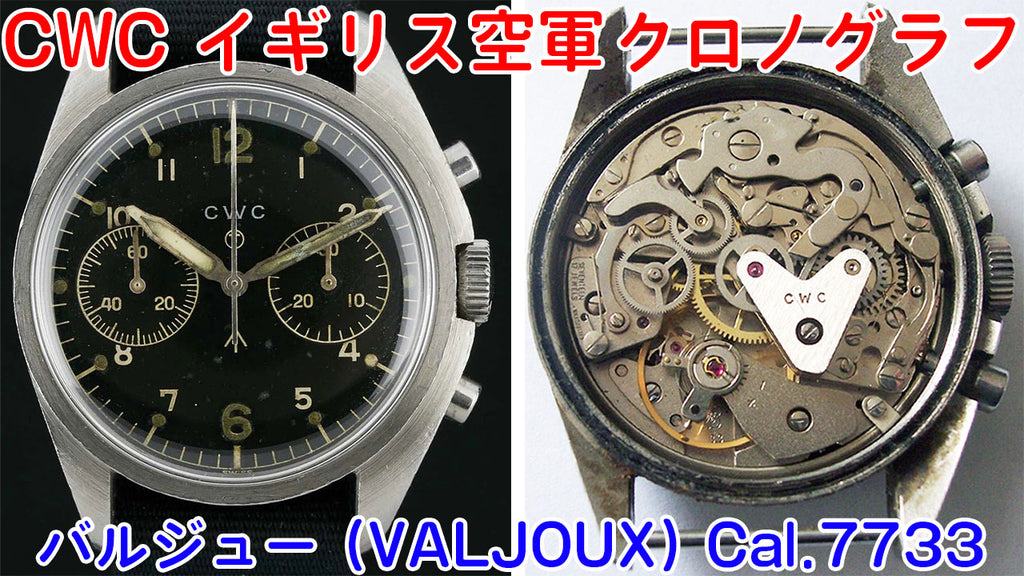
The appearance has changed significantly, and as there was an issue with the absence of a brake lever, a new brake lever has been installed.

The movement equipped with the Valjoux 7733 was proven to be capable of producing reliable accuracy in chronographs, and so it was adopted as a watch for the Royal Air Force.

The watches were delivered by Precista, CWC, Hamilton, and Newmark, and you can see that the dials are all very similar.
All of these watches are equipped with the Valjoux 7733 movement.
After the Valjoux 7733, which was equipped with this brake lever, the era of the competition to develop automatic chronographs began.
The Birth of the Chronomatic Cal.11
In this situation, each brand, realizing that there were limitations to their own technology, formed an alliance.
The alliance was made up of Heuer, Breitling and Dubois-Dépraz.
The reason why it has not been possible to make an automatic chronograph to this day is due to space and structural issues associated with incorporating a three-hand watch module, a thick automatic rotor, and a chronograph function.
So, Gerald from Dubois proposed combining a chronograph module with a micro-rotor.
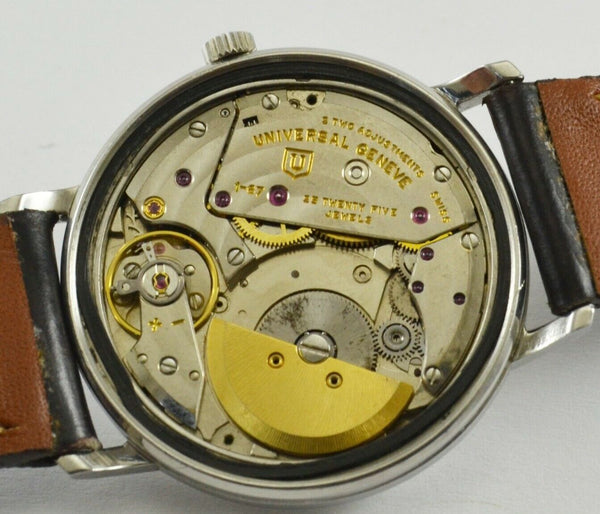
As you can see, the small semicircle is a micro-rotor, which is smaller than the large rotors that were used up until then, allowing for more space to be saved.
Then, Buren, which held the patent for the micro-rotor, joined the alliance.
In March 1969, the Chronomatic Cal. 11 was released.

However, automatic chronographs equipped with this micro-rotor had a weakness: the micro-rotors of the time were small, which meant that the winding efficiency was poor and there was still a need for improvement.
By the way,
It is said that the first full-fledged micro-rotor was introduced when Patek Philippe released the Cal. 240 in 1977, and up until that point, micro-rotors were not in widespread use.
The Birth of the Valjoux Caliber 7750
Therefore, the next model will be developed as soon as possible, which will be the Cal. 7750, which is based on the Valjoux 7733 design.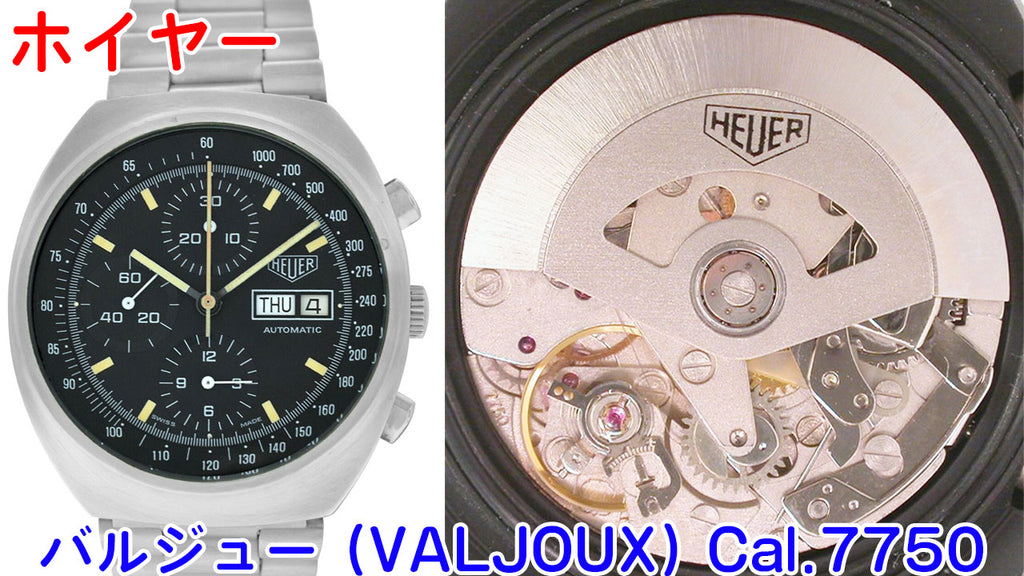
This was in 1973, when the Cal. 7750 hit the market as the world's first computer-designed watch.
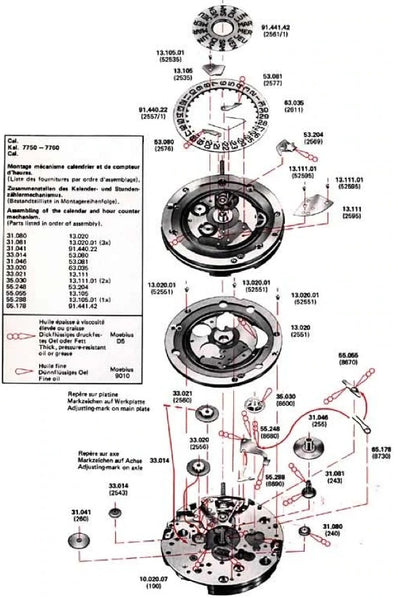
The Cal. 7750 is a relatively thick and large movement that is reliable and offers excellent cost performance.
However, it overcomes the drawback of micro rotors in terms of winding efficiency.
The big step was to overcome the original problems with the structure and space, and secure the space to install the large rotor. (I won't go into details about the swing pinion and the clutch, because it will make the story confusing.)
Because the rotor is relatively large and heavy, it can wind the mainspring efficiently, even in one direction.
In short, the Valjoux Cal. 7750 is the strongest movement, inheriting the spirit of the Venus Cal. 178 and the Chronomatic Cal. 11.
Valjoux was later acquired by ETA and the name was changed to ETA7750, but this caliber continues to be loved today nonetheless, for its excellent functionality and ease of maintenance.
Approached from a different direction,
For more information on the automatic chronograph alliances Zenith, Movado, and SEIKO, please see this video:
summary
When comparing the column wheel type and the cam type, the column wheel type seems to be more commonly found on high-end models.
This is probably because a smooth button feel is required to prove that the device is a high-end device.
However, you should understand that in reality, they are now the same in terms of functionality.
It goes without saying that all high-end models are good, but you also need to consider how much money you can spend.
Even if a cam system is used, the options can be increased with proper structure and knowledge.
I've talked about everything from the manual-winding chronograph to the ETA7750, and I hope you've realized that they are not all different movements, but rather that they have evolved while inheriting their DNA.
Among the hand-wound movements, there is the column wheel type, the cam type, and the automatic winding type, each of which has its own advantages and disadvantages, and I believe that you can only fully appreciate them if you understand their unique appeal.



